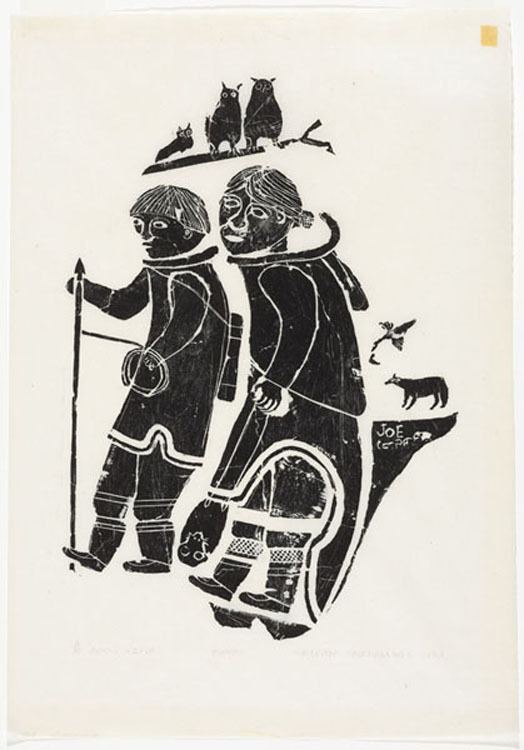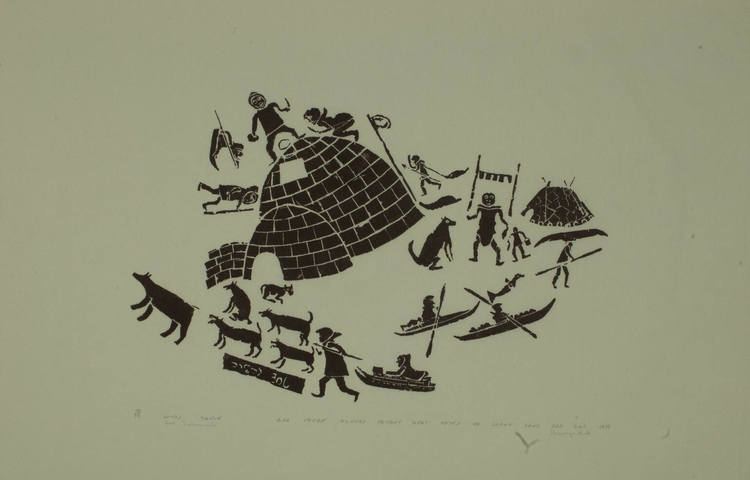Name Joe Talirunili | Died 1976, Puvirnituq, Canada | |
 | ||
Joe talirunili 1893 1976 e9 818 povungnituk the migration
Joe Talirunili (ca. 1893–1976) was an Inuit printmaker and sculptor, who would sometimes draw. There are two different places listed of where the artist was born, Qugaaluk River camp, Quebec, or 50 kilometers north of Puvirnituq in Nunavik Province, Quebec, at Neahungnik camp Another mystery is when the artist was born and when he died. The Department of Indian and Northern Affairs in Ottawa says he was born in 1893, but the artist claims that 1906 is the correct year, but there is no indication of when the month and day was. The dates of his death are September 13, 1976 or September 11, 1976.
Contents
- Joe talirunili 1893 1976 e9 818 povungnituk the migration
- Joe talirunili migration
- The migration
- Exposure to art
- Talirunilis art timeline
- Purivnituq Print Shop
- References

Joe talirunili migration
The migration

Joe was brought up with the traditional lifestyle of the Inuit. When he was younger, he spent most of his time with his father hunting in the Kuujjuarapik and Richmond Gulf region. The Inuit move camp and follow the caribou as a part of their hunting lifestyle. When Talirunili was younger, he was in a migration. This migration was a traumatic incident that happened in Joe’s life.

A group of about forty people were traveling to new hunting grounds on an island in Hudson Bay. The crew got into a shipwreck and the ice floe that they were on had broken off the edge of the sea ice. The people had to use the sealskins, rope and wood from their sleds to make an umiak (a skin boat). They worked against nature’s time of the ice melting; some people did not survive. The boat full of people floated for days before they reached land. This experience influenced and inspired the artist to create sculptures of “The Migration,' which are also called, "Joe Boats."
Exposure to art
Joe was exposed to the non-Inuit lifestyle at an early age because his father worked with the mining prospectors. In the 1950s, the non-Inuit started to settle in Puvirnituq, this gave Talirunili the opportunity to work with them in order to support his family by not only hunting. This also gave him the opportunity to learn about creating art in printmaking, sculpting and drawing.
Talirunili's art timeline
In the 1950s, Talirunili focused more on sculptures. He carved migration scenes of umiaks, Inuit men and women, hunting scenes and caribou. After a decade of sculpting, he got into printmaking graphics in the 1960s. In all of Joe’s work, sculptures, prints and drawings, he tells stories from his traditions, childhood and people’s lives, camp life, hunting scenes, owls, other animals and his famous “migration” works.
Purivnituq Print Shop
Joe Talirunili and his cousin, David Ialuk were one of the founding members of the Purivnituq print shop. In Joe’s lifetime, he made about over seventy prints. His graphics were put into the Puvirnituq annual print collections in the 1960s. In 1978, one of Joe’s sculptures was reproduced on a 1978 Canadian postage stamp.
